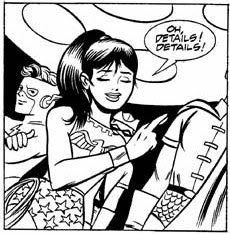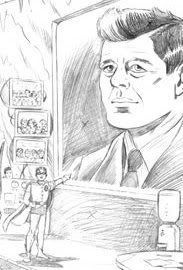We Found It: Jog scratches up some 1/9
/![]() Note that while the images I'm posting in the following review are in b&w, the actual comic is in full Laura Allred color. I just can't seem to find any color preview material, save for the Nick Cardy/Dave Stewart cover. To wit:
Note that while the images I'm posting in the following review are in b&w, the actual comic is in full Laura Allred color. I just can't seem to find any color preview material, save for the Nick Cardy/Dave Stewart cover. To wit:

Teen Titans: The Lost Annual: This was originally known as the Teen Titans Swingin' Elseworlds Special, back in 2003 when it was first expected for release. The story and art were complete at that time, but the material was nonetheless denied publication for reasons that remain somewhat vague to this day. Penciller Jay Stephens has recently cited the dialing down of the Elseworlds line and a potential for confusion with the contemporaneous launch of the Geoff Johns-written Titans series as contributing to the situation, while earlier accounts suggested everything from the book's 'uncommercial' and 'weird' nature to its anti-war slant in the face of the just-begun Iraq conflict -- or even spillover controversy from inker Mike Allred's presence as artist on Marvel's X-Statix, then under close scrutiny due to its planned (and later aborted) Princess Di storyline -- as reasons for the postponement.
Regardless, it's only seeing print now as a pamphlet-format Annual, with last week's (cute as a button) Teen Titans Year One launch providing a nebulous tie-in. But while that current miniseries updates the original Titans lineup to adolescents of the modern age, this book sees the team romping around the '60s heyday of writer/co-creator Bob Haney, here providing his final comics script. It's not a clean timeline, mind you - the Titans didn't debut until 1964, while this story (by its own plot details) takes place no later than 1962, even though the team is already fully formed, and specific period details don't quite match up. The Elizabeth Taylor movie Cleopatra didn't open until after the Cuban Missile Crisis, for example.

Not that it matters much, given the deliriously messy allegory Haney cooks up. The story sees the team (minus useless Aqualad) whisked away to an alien world to save a brainwashed President John F. Kennedy from escalating a conflict between blue-skinned 'mod'/Yellow Submarine types and furry brown knife-swinging quasi-hippies, thus accounting for inter-counterculture strife, racial disharmony and Vietnam, all of it presented as the 'straight' Titans dealing with shifting cultural tides, while also simultaneously presenting JFK as an avatar for the decade's conflicted yearning for war and peace. In terms of sheer ambition, Haney's got the recent works of Stan Lee beat easily.
Truth be told, it's somewhat haphazard and overextended as a story, and I suspect a good portion of its success belongs squarely to the aforementioned art team; contrary to Hibbs, I liked Stephens as inked by Allred, in that the latter solidifies the former's simpler designs into just the sort of general DC '60s look amenable to conveying the broad swathe of time implicated by the script. I suspect the reverse would have looked too much like... Mike Allred, thus distracting things with specificity. And any less technically skilled a combo might have let the pages collapse into jabbering nonsense.
As it is, things proceed conductively, even as Haney piles on action sequence after action sequence, extends a Wonder Girl romantic betrayal well past the point of interest, and has the brainwashing plot turn on a scheme involving: (a) a special hat; and (b) potentially deadly blunt force trauma. Never mind that (b) does rather cancel out (a) in the world of logic - this story takes place on Earth Propulsion, and Robin only needs retrive a hat so that things can keep on moving.

In spite of that, I do feel this is still a GOOD comic, because Haney's hyperactive storytelling and inclusive setting, as well-served by the art as they are, ultimately compliment his extra-broad themes. This isn't any plainclothes 'relevant' story - it's a big, loud superhero epic aiming to embody a big, loud time, with larger-than-life symbols of one or more mighty social forces thundering around to and fro.
For example, one could say that Haney's characterization of the clear-minded Kennedy as a tireless advocate of peace is up for debate, but he's really playing off the notion of Camelot, the feeling that Kennedy came to embody for some, a state that's worth grasping in a superhero comic of this sort: everyone is sort of decent, nobody is beyond recovery and all trespasses are forgiven. This is presented as the natural state of affairs for superheroes, or at least the young superheroes of that time, acting as both reflections of and engines behind a distinct idealism. In this construct, they act to bring out the cooperative state in everyone.
That kind of thing can't really sustain itself, and the book knows it. The story ends with a major blow toward idealism (though, in keeping with the plot's temporal jumble, it's a shot fired before a lot of the strife represented earlier), and there's tears on the final page. As such, the story does feel like a final Titans adventure, if only in that it acknowledges the eventual downgrading of its own worldview. Growing old, if you will. It's is a hopeful comic book fantasy, however, and it suggests that not only could the heroes keep on fighting, but that the spirit of the time has merely gone somewhere else, and can be presumably be recalled. An effective sentiment for a comic so steeped in an older aesthetic - it's too damned upbeat to admit that funnies of this kind can't come back. I mean, look at what's in your hands!
Of course, that was all in a comic meant for 2003. And then it was 2004, and Bob Haney died. And now it is 2008, and the comic is finally here. And I think, in spite of all positive thought, it is not as easy as it seems.











